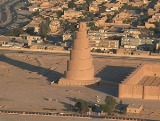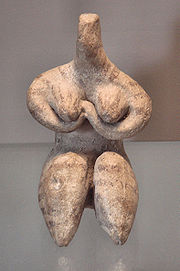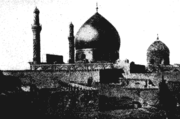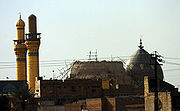
Samarra
Encyclopedia
Sāmarrā is a city in Iraq
Iraq
Iraq ; officially the Republic of Iraq is a country in Western Asia spanning most of the northwestern end of the Zagros mountain range, the eastern part of the Syrian Desert and the northern part of the Arabian Desert....
. It stands on the east bank of the Tigris
Tigris
The Tigris River is the eastern member of the two great rivers that define Mesopotamia, the other being the Euphrates. The river flows south from the mountains of southeastern Turkey through Iraq.-Geography:...
in the Salah ad-Din Governorate, 125 kilometres (77.7 mi) north of Baghdad
Baghdad
Baghdad is the capital of Iraq, as well as the coterminous Baghdad Governorate. The population of Baghdad in 2011 is approximately 7,216,040...
and, in 2003, had an estimated population of 348,700.
Medieval Islamic writers believed that the name “Samarra” is derived from the Arabic phrase “Surra man ra’a” , which translates to “A joy for all who see”.
In 2007, UNESCO
UNESCO
The United Nations Educational, Scientific and Cultural Organization is a specialized agency of the United Nations...
named Samarra one of its World Heritage Sites.
Ancient Samarra

Ernst Herzfeld
Ernst Emil Herzfeld was a German archaeologist and Iranologist.-Life:Herzfeld was born in Celle, Province of Hanover...
. Since 1946, the notebooks, letters, unpublished excavation reports and photographs have been in the Freer Gallery of Art
Freer Gallery of Art
The Freer Gallery of Art joins the Arthur M. Sackler Gallery to form the Smithsonian Institution's national museums of Asian art. The Freer contains art from East Asia, South Asia, Southeast Asia, the Islamic world, the ancient Near East, and ancient Egypt, as well as a significant collection of...
in Washington, DC.
Though the present archaeological site covered by mudbrick ruins is vast, the site of Samarra was only lightly occupied in ancient times, apart from the Chalcolithic Samarran Culture (ca 5500–4800 BC) identified at the rich site of Tell Sawwan
Tell es Sawwan
Tell es-Sawwan was a city in ancient Mesopotamia 110 kilometers north of Baghdad, and south of Samarra.-History:The site is a primarily Ubaid, Hassuna, and Samarran culture occupation with some later Babylonian graves...
, where evidence of irrigation—including flax
Flax
Flax is a member of the genus Linum in the family Linaceae. It is native to the region extending from the eastern Mediterranean to India and was probably first domesticated in the Fertile Crescent...
— establishes the presence of a prosperous settled culture with a highly organized social structure. The culture is primarily known by its finely-made pottery decorated against dark-fired backgrounds with stylized figures of animals and birds and geometric designs. This widely-exported type of pottery, one of the first widespread, relatively uniform pottery styles in the Ancient Near East
Ancient Near East
The ancient Near East was the home of early civilizations within a region roughly corresponding to the modern Middle East: Mesopotamia , ancient Egypt, ancient Iran The ancient Near East was the home of early civilizations within a region roughly corresponding to the modern Middle East: Mesopotamia...
, was first recognized at Samarra. The Samarran Culture was the precursor to the Mesopotamia
Mesopotamia
Mesopotamia is a toponym for the area of the Tigris–Euphrates river system, largely corresponding to modern-day Iraq, northeastern Syria, southeastern Turkey and southwestern Iran.Widely considered to be the cradle of civilization, Bronze Age Mesopotamia included Sumer and the...
n culture of the Ubaid period
Ubaid period
The Ubaid period is a prehistoric period of Mesopotamia. The tell of al-`Ubaid west of nearby Ur in southern Iraq's Dhi Qar Governorate has given its name to the prehistoric Pottery Neolithic to Chalcolithic culture, which represents the earliest settlement on the alluvial plain of southern...
.
A city of Sur-marrati, refounded by Sennacherib
Sennacherib
Sennacherib |Sîn]] has replaced brothers for me"; Aramaic: ) was the son of Sargon II, whom he succeeded on the throne of Assyria .-Rise to power:...
in 690 BC according to a stele
Stele
A stele , also stela , is a stone or wooden slab, generally taller than it is wide, erected for funerals or commemorative purposes, most usually decorated with the names and titles of the deceased or living — inscribed, carved in relief , or painted onto the slab...
in the Walters Art Gallery, Baltimore, is insecurely identified with a fortified Assyria
Assyria
Assyria was a Semitic Akkadian kingdom, extant as a nation state from the mid–23rd century BC to 608 BC centred on the Upper Tigris river, in northern Mesopotamia , that came to rule regional empires a number of times through history. It was named for its original capital, the ancient city of Assur...
n site of Assyrian at al-Huwaysh, on the Tigris opposite to modern Samarra.
Ancient toponyms for Samarra noted by the Samarra Archaeological Survey are Greek Souma (Ptolemy
Ptolemy
Claudius Ptolemy , was a Roman citizen of Egypt who wrote in Greek. He was a mathematician, astronomer, geographer, astrologer, and poet of a single epigram in the Greek Anthology. He lived in Egypt under Roman rule, and is believed to have been born in the town of Ptolemais Hermiou in the...
V.19, Zosimus
Zosimus
Zosimus was a Byzantine historian, who lived in Constantinople during the reign of the Byzantine Emperor Anastasius I . According to Photius, he was a comes, and held the office of "advocate" of the imperial treasury.- Historia Nova :...
III, 30), Latin Sumere, a fort mentioned during the retreat of the army of Julian the Apostate
Julian the Apostate
Julian "the Apostate" , commonly known as Julian, or also Julian the Philosopher, was Roman Emperor from 361 to 363 and a noted philosopher and Greek writer....
in 364 AD (Ammianus Marcellinus
Ammianus Marcellinus
Ammianus Marcellinus was a fourth-century Roman historian. He wrote the penultimate major historical account surviving from Antiquity...
XXV, 6, 4), and Syriac Sumra (Hoffmann, Auszüge, 188; Michael the Syrian
Michael the Syrian
Michael the Syrian , also known as Michael the Great or Michael Syrus or Michael the Elder, to distinguish him from his nephew, was a patriarch of the Syriac Orthodox Church from 1166 to 1199. He is best known today as the author of the largest medieval Chronicle, which he composed in Syriac...
, III, 88), described as a village.
The possibility of a larger population was offered by the opening of the Qatul al-Kisrawi, the northern extension of the Nahrawan canal which drew water from the Tigris
Tigris
The Tigris River is the eastern member of the two great rivers that define Mesopotamia, the other being the Euphrates. The river flows south from the mountains of southeastern Turkey through Iraq.-Geography:...
in the region of Samarra, attributed by Yaqut (Mu`jam see under "Qatul") to the Sassanid
Sassanid Empire
The Sassanid Empire , known to its inhabitants as Ērānshahr and Ērān in Middle Persian and resulting in the New Persian terms Iranshahr and Iran , was the last pre-Islamic Persian Empire, ruled by the Sasanian Dynasty from 224 to 651...
king Khosrau I Anushirvan (531–578). To celebrate the completion of this project, a commemorative tower (modern Burj al-Qa'im) was built at the southern inlet south of Samarra, and a palace with a "paradise" or walled hunting park was constructed at the northern inlet (modern Nahr al-Rasasi) near to al-Daur. A supplementary canal, the Qatul Abi al-Jund, excavated by the Abbasid Caliph Harun al-Rashid
Harun al-Rashid
Hārūn al-Rashīd was the fifth Arab Abbasid Caliph in Iraq. He was born in Rey, Iran, close to modern Tehran. His birth date remains a point of discussion, though, as various sources give the dates from 763 to 766)....
, was commemorated by a planned city laid out in the form of a regular octagon (modern Husn al-Qadisiyya), called al-Mubarak and abandoned unfinished in 796.
Abbasid capital
In 836 the AbbasidAbbasid
The Abbasid Caliphate or, more simply, the Abbasids , was the third of the Islamic caliphates. It was ruled by the Abbasid dynasty of caliphs, who built their capital in Baghdad after overthrowing the Umayyad caliphate from all but the al-Andalus region....
caliphate's
Caliphate
The term caliphate, "dominion of a caliph " , refers to the first system of government established in Islam and represented the political unity of the Muslim Ummah...
Turkic
Turkic peoples
The Turkic peoples are peoples residing in northern, central and western Asia, southern Siberia and northwestern China and parts of eastern Europe. They speak languages belonging to the Turkic language family. They share, to varying degrees, certain cultural traits and historical backgrounds...
slave soldiers — known as Mamluk
Mamluk
A Mamluk was a soldier of slave origin, who were predominantly Cumans/Kipchaks The "mamluk phenomenon", as David Ayalon dubbed the creation of the specific warrior...
— agitated the citizens of Baghdad
Baghdad
Baghdad is the capital of Iraq, as well as the coterminous Baghdad Governorate. The population of Baghdad in 2011 is approximately 7,216,040...
, provoking riots.
The capital of the Caliphate was moved from Baghdad to the new city of Samarra later that year by Caliph
Caliph
The Caliph is the head of state in a Caliphate, and the title for the ruler of the Islamic Ummah, an Islamic community ruled by the Shari'ah. It is a transcribed version of the Arabic word which means "successor" or "representative"...
Al-Mu'tasim
Al-Mu'tasim
Abu Ishaq 'Abbas al-Mu'tasim ibn Harun was an Abbasid caliph . He succeeded his half-brother al-Ma'mun...
.
During this time the original pre-Islam
Islam
Islam . The most common are and . : Arabic pronunciation varies regionally. The first vowel ranges from ~~. The second vowel ranges from ~~~...
ic settlement was replaced with a new city established in 833. Samara would remain the capital of the Muslim
Muslim
A Muslim, also spelled Moslem, is an adherent of Islam, a monotheistic, Abrahamic religion based on the Quran, which Muslims consider the verbatim word of God as revealed to prophet Muhammad. "Muslim" is the Arabic term for "submitter" .Muslims believe that God is one and incomparable...
world until 892 when it was returned to Baghdad by al-Mu'tamid
Al-Mu'tamid
This article is about the Abbasid Caliph al-Mu'tamid of Baghdad. For the Andalusi Arabic poet who was also the Abbadid king of Seville, see Muhammad Ibn Abbad Al Mutamid...
. Al-Mu'tasim's successor, al-Wathiq
Al-Wathiq
Al-Wathiq ibn Mutasim was an Abbasid caliph who reigned from 842 until 847 AD .-Biography:...
, developed Samara into a commercial city, and it was further developed under Caliph al-Mutawakkil
Al-Mutawakkil
Al-Mutawakkil ʻAlā Allāh Jaʻfar ibn al-Muʻtasim was an Abbasid caliph who reigned in Samarra from 847 until 861...
. The latter sponsored the construction of the Great Mosque of Samarra
Great Mosque of Samarra
The Great Mosque of Samarra is a 9th century mosque located in Samarra, Iraq. The mosque was commissioned in 848 and completed in 851 by the Abbasid caliph Al-Mutawakkil who reigned from 847 until 861....
with its spiral minaret
Minaret
A minaret مناره , sometimes مئذنه) is a distinctive architectural feature of Islamic mosques, generally a tall spire with an onion-shaped or conical crown, usually either free standing or taller than any associated support structure. The basic form of a minaret includes a base, shaft, and gallery....
or malwiyah, built in 847. He also laid out parks and a palace for his son al-Mu'tazz
Al-Mu'tazz
Al-Mu'tazz was the title of the Abbasid Caliph in Baghdad from 866 to 869. Placed upon the throne by the Turks, he proved but too apt a pupil of his Turkish masters.He became the caliph at 19 he was the youngest Abbasaid Caliph to assume power. He was surrounded by parties each jealous of the other...
.
The Nestorian patriarch Sargis
Sargis (Nestorian Patriarch)
Sargis was Patriarch of the Church of the East between 860 and 872.- Sources :Brief accounts of Sargis's patriarchate are given in the Ecclesiastical Chronicle of the Jacobite writer Bar Hebraeus and in the ecclesiastical histories of the Nestorian writers Mari , Amr and Sliba .- Sargis's...
(860–72) moved the patriarchal seat of the Church of the East
Church of the East
The Church of the East tāʾ d-Maḏnḥāʾ), also known as the Nestorian Church, is a Christian church, part of the Syriac tradition of Eastern Christianity. Originally the church of the Persian Sassanid Empire, it quickly spread widely through Asia...
from Baghdad to Samarra, and one or two of his immediate successors may also have sat in Samarra so as to be close to the seat of power.
Under the rule of al-Mu'tadid
Al-Mu'tadid
Al-Mu'tadid was the Abbasid Caliph in Baghdad from 892 to 902. As the son and heir of the powerful vizier and virtual regent Al-Muwaffaq , Mu'tadid was already in possession of supreme power even before he was appointed Caliph, and continued as Caliph to ably administer the Government...
, the Abbassid capital was shifted back to Baghdad and Samarra entered a prolonged decline(which accelerated after the 13th century when the course of the Tigris shifted). Much of this was due to the Turkish officers in the government, who made the caliph a puppet and took control of the state through assasination and intrigue.
Islamic significance

Al-Askari Mosque
Al ‘Askarī Mosque or the ‘Askariyya Mosque/Shrine is a Shī‘ah Muslim holy site located in the Iraqi city of Sāmarrā from Baghdad. It is one of the most important Shī‘ah mosques in the world, built in 944...
, containing the mausoleums of the 'Ali al-Hadi and Hasan al-Askari
Hasan al-Askari
Hasan al-‘Askarī was the eleventh of the Twelve Imams. His given name was Hasan ibn ‘Alī ibn Muhammad...
, the tenth and eleventh Shia Imams, respectively, as well as the shrine of Muhammad al-Mahdi
Muhammad al-Mahdi
Muḥammad ibn al-Ḥasan al-Mahdī is believed by Twelver Shī‘a Muslims to be the Mahdī, an ultimate savior of humankind and the final Imām of the Twelve Imams...
, known as the "Hidden Imam", who is the twelfth and final Imam of the Shia of the Ja'farī Madhhab. This has made it an important pilgrimage centre for Ja'farī Shia Muslims. In addition, Hakimah Khatun and Narjis Khatun, female relatives of the Prophet Mohammed and the Shia Imams, held in high esteem by Shia and Sunni Muslims, are buried there, making this mosque one of the most significant sites of worship for Shia and a venerated location for Sunni Muslims.
The people of Samarra belong to tribes that are known to descendents of al-Hussein (son of 'Ali). While the vast majority of Samarra's native citizens are Sunnis and the Sunnis do not share the same religious practices that the Ja'farī Madhhab Shi'a of Iraq do, they consider these to be the grave sites of their forefathers and the pillars of Islam ('Ali al-Hadi and Hasan al-Askari).
The Sunnis also pray in the mosques similar to the Shiites; they also (even as far as from South Asia) conduct pilgrimages to these sites, but they do not believe this to be obligatory, simply an affair of spiritual blessings.
Modern era
During the 20th century, Samarra' gained new importance when a permanent lake (Lake ThartharLake Tharthar
Lake Tharthar, known in Iraq as Buhayrat ath Tharthar , is a lake situated 120 kilometers north of Baghdad between the Tigris and the Euphrates rivers. It is the largest lake in Iraq. The construction of several dams has made it an important source for irrigation. Its size shrinks and expands...
) was created near the town by the Samarra Dam
Samarra Dam
Samarra Dam or Barrage and Thar Thar Dam or Barrage is a multi-purpose dam on the Tigris River adjacent of Samarra and north of Baghdad, Iraq...
in order to end the frequent flooding of Baghdad downstream. Many local people were displaced by the dam, resulting in a big increase in Samarra's population.
Samarra is a key city in Salahaddin province, a major part of the so-called Sunni Triangle where insurgents have been active since shortly after 2003 invasion by the United States of America.
Though Samarra is famous as a site of Shi'a holy sites, including the tombs of several Shi'a Imams, the town is dominated by Sunnis. This has caused tensions, particularly since the 2003 invasion of Iraq
2003 invasion of Iraq
The 2003 invasion of Iraq , was the start of the conflict known as the Iraq War, or Operation Iraqi Freedom, in which a combined force of troops from the United States, the United Kingdom, Australia and Poland invaded Iraq and toppled the regime of Saddam Hussein in 21 days of major combat operations...
.
On February 22, 2006, the golden dome of the al-Askari Mosque
Al-Askari Mosque
Al ‘Askarī Mosque or the ‘Askariyya Mosque/Shrine is a Shī‘ah Muslim holy site located in the Iraqi city of Sāmarrā from Baghdad. It is one of the most important Shī‘ah mosques in the world, built in 944...
was destroyed by bombs, setting off a period of rioting and reprisal attacks across the country which claimed hundreds of lives. No organizations have claimed responsibility.
On June 13, 2007, suspected al-Qa'eda insurgents attacked the mosque
2007 al-Askari Mosque bombing
The 2007 al-Askari Mosque bombing occurred on June 13, 2007 at around 9 a.m. local time at one of the holiest sites in Shia Islam, the al-Askari Mosque, and has been attributed to al-Qaeda in Iraq or the Iraqi Baath Party. While there were no injuries or deaths reported, the mosque's two ten...
again and destroyed the two minaret
Minaret
A minaret مناره , sometimes مئذنه) is a distinctive architectural feature of Islamic mosques, generally a tall spire with an onion-shaped or conical crown, usually either free standing or taller than any associated support structure. The basic form of a minaret includes a base, shaft, and gallery....
s that flanked the dome's ruins. On July 12, 2007 the clock tower was blown up. No fatalities were reported. Shiite cleric Muqtada al-Sadr
Muqtada al-Sadr
Sayyid Muqtadā al-Ṣadr is an Iraqi Islamic political leader.Along with Ali al-Sistani and Ammar al-Hakim of the Islamic Supreme Council of Iraq, Sadr is one of the most influential religious and political figures in the country not holding any official title in the Iraqi government.-Titles:He is...
called for peaceful demonstrations and three days of mourning. He stated that he believed no Sunni Arab
Arab
Arab people, also known as Arabs , are a panethnicity primarily living in the Arab world, which is located in Western Asia and North Africa. They are identified as such on one or more of genealogical, linguistic, or cultural grounds, with tribal affiliations, and intra-tribal relationships playing...
could have been behind the attack. The mosque compound and minarets had been closed since the 2006 bombing. An indefinite curfew was placed on the city by the Iraqi police.

Prior to the second bombing, the gayaameen were also relieved, except this time it was done by Internal Ministry officers (Maghaweer al-dakhiliah) accompanied by coalition troops. The gayaameen this time were instructed to move to the bridge that connects Samarra proper with the Gal'a (explanation needed) and establish a check point there. Soon after, the bombings occurred, destroying the shrine for a second time.
'Appointment in Samarra'
The metaphor of "Having an appointment in Samarra", signifying death, is a rare literary reference to a short story of unknown origin transcribed by W. Somerset MaughamW. Somerset Maugham
William Somerset Maugham , CH was an English playwright, novelist and short story writer. He was among the most popular writers of his era and, reputedly, the highest paid author during the 1930s.-Childhood and education:...
. The story was titled 'The Appointment in Samarra', and subsequently formed the germ of the novel Appointment in Samarra
Appointment in Samarra
Appointment in Samarra, published in 1934, is the first novel by John O'Hara. It concerns the self-destruction of Julian English, once a member of the social elite of Gibbsville ....
by John O'Hara
John O'Hara
John Henry O'Hara was an American writer. He initially became known for his short stories and later became a best-selling novelist whose works include Appointment in Samarra and BUtterfield 8. He was particularly known for an uncannily accurate ear for dialogue...
. The original story was re-told in verse by F. L. Lucas
F. L. Lucas
Frank Laurence Lucas was an English classical scholar, literary critic, poet, novelist, playwright, political polemicist, and Fellow of King's College, Cambridge....
in his poem 'The Destined Hour' in From Many Times and Lands (1953).

